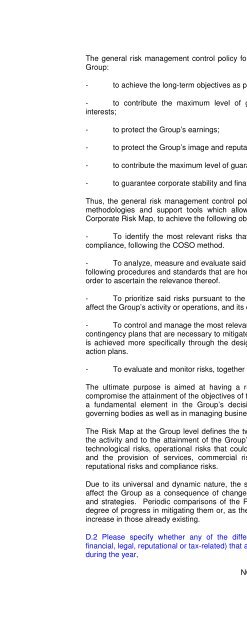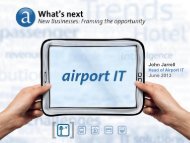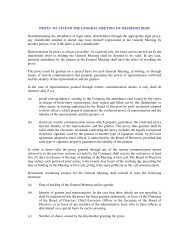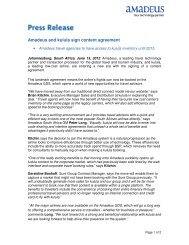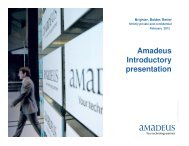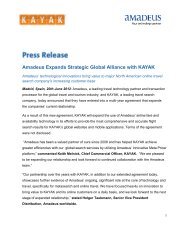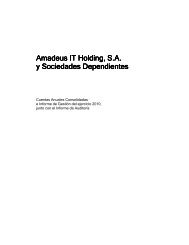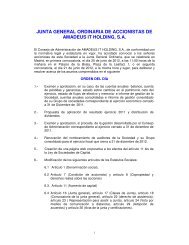- Page 1 and 2:
Amadeus Annual Report 2010
- Page 4:
Index CEO message__________________
- Page 8:
Amadeus at a glance 1
- Page 12:
12 | Amadeus Annual Report 2010 Ann
- Page 16:
16 | Amadeus Annual Report 2010 Ann
- Page 20:
20 | Amadeus Annual Report 2010 Ann
- Page 24:
24 | Amadeus Annual Report 2010 Ann
- Page 28:
28 | Amadeus Annual Report 2010 Ann
- Page 32:
32 | Amadeus Annual Report 2010 Ann
- Page 36:
36 | Amadeus Annual Report 2010 Ann
- Page 40:
40 | Amadeus Annual Report 2010 Ann
- Page 44:
44 | Amadeus Annual Report 2010 Ann
- Page 48:
48 | Amadeus Annual Report 2010 Ann
- Page 52:
52 | Amadeus Annual Report 2010 Ann
- Page 56:
56 | Amadeus Annual Report 2010 Ann
- Page 60:
60 | Amadeus Annual Report 2010 Ann
- Page 64:
64 | Amadeus Annual Report 2010 Ann
- Page 68:
68 | Amadeus Annual Report 2010 Ann
- Page 72:
72 | Amadeus Annual Report 2010 Ann
- Page 76:
76 | Amadeus Annual Report 2010 Ann
- Page 80:
80 | Amadeus Annual Report 2010 Ann
- Page 84:
84 | Amadeus Annual Report 2010 Ann
- Page 88:
26 Economic, social and environment
- Page 92:
92 | Amadeus Annual Report 2010 Ann
- Page 96:
96 | Amadeus Annual Report 2010 Ann
- Page 100:
100 | Amadeus Annual Report 2010 An
- Page 104:
104 | Amadeus Annual Report 2010 An
- Page 108:
108 | Amadeus Annual Report 2010 An
- Page 112:
112 | Amadeus Annual Report 2010 An
- Page 116:
116 | Amadeus Annual Report 2010 Co
- Page 120:
CONSOLIDATED FINANCIAL INFORMATION
- Page 126:
AMADEUS IT HOLDING, S.A. AND SUBSID
- Page 130:
AMADEUS IT HOLDING, S.A. AND SUBSID
- Page 134:
AMADEUS IT HOLDING, S.A. AND SUBSID
- Page 138:
AMADEUS IT HOLDING, S.A. AND SUBSID
- Page 142:
AMADEUS IT HOLDING, S.A. AND SUBSID
- Page 146:
AMADEUS IT HOLDING, S.A. AND SUBSID
- Page 150:
AMADEUS IT HOLDING, S.A. AND SUBSID
- Page 154:
AMADEUS IT HOLDING, S.A. AND SUBSID
- Page 158:
AMADEUS IT HOLDING, S.A. AND SUBSID
- Page 162:
AMADEUS IT HOLDING, S.A. AND SUBSID
- Page 166:
AMADEUS IT HOLDING, S.A. AND SUBSID
- Page 170:
AMADEUS IT HOLDING, S.A. AND SUBSID
- Page 174:
AMADEUS IT HOLDING, S.A. AND SUBSID
- Page 178:
AMADEUS IT HOLDING, S.A. AND SUBSID
- Page 182:
AMADEUS IT HOLDING, S.A. AND SUBSID
- Page 186:
AMADEUS IT HOLDING, S.A. AND SUBSID
- Page 190:
AMADEUS IT HOLDING, S.A. AND SUBSID
- Page 194:
AMADEUS IT HOLDING, S.A. AND SUBSID
- Page 198:
AMADEUS IT HOLDING, S.A. AND SUBSID
- Page 202:
AMADEUS IT HOLDING, S.A. AND SUBSID
- Page 206:
AMADEUS IT HOLDING, S.A. AND SUBSID
- Page 210:
AMADEUS IT HOLDING, S.A. AND SUBSID
- Page 214:
AMADEUS IT HOLDING, S.A. AND SUBSID
- Page 218:
AMADEUS IT HOLDING, S.A. AND SUBSID
- Page 222:
AMADEUS IT HOLDING, S.A. AND SUBSID
- Page 226:
AMADEUS IT HOLDING, S.A. AND SUBSID
- Page 230:
AMADEUS IT HOLDING, S.A. AND SUBSID
- Page 234:
AMADEUS IT HOLDING, S.A. AND SUBSID
- Page 238:
AMADEUS IT HOLDING, S.A. AND SUBSID
- Page 242:
AMADEUS IT HOLDING, S.A. AND SUBSID
- Page 246:
AMADEUS IT HOLDING, S.A. AND SUBSID
- Page 250:
AMADEUS IT HOLDING, S.A. AND SUBSID
- Page 254:
AMADEUS IT HOLDING, S.A. AND SUBSID
- Page 258:
AMADEUS IT HOLDING, S.A. AND SUBSID
- Page 262:
AMADEUS IT HOLDING, S.A. AND SUBSID
- Page 266:
AMADEUS IT HOLDING, S.A. AND SUBSID
- Page 270:
AMADEUS IT HOLDING, S.A. AND SUBSID
- Page 274:
AMADEUS IT HOLDING, S.A. AND SUBSID
- Page 278:
AMADEUS IT HOLDING, S.A. AND SUBSID
- Page 282:
AMADEUS IT HOLDING, S.A. AND SUBSID
- Page 286:
AMADEUS IT HOLDING, S.A. AND SUBSID
- Page 290:
AMADEUS IT HOLDING, S.A. AND SUBSID
- Page 294:
AMADEUS IT HOLDING, S.A. AND SUBSID
- Page 298:
AMADEUS IT HOLDING, S.A. AND SUBSID
- Page 302:
AMADEUS IT HOLDING, S.A. AND SUBSID
- Page 306:
AMADEUS IT HOLDING, S.A. AND SUBSID
- Page 310:
AMADEUS IT HOLDING, S.A. AND SUBSID
- Page 314:
AMADEUS IT HOLDING, S.A. AND SUBSID
- Page 318:
AMADEUS IT HOLDING, S.A. AND SUBSID
- Page 322:
AMADEUS IT HOLDING, S.A. AND SUBSID
- Page 326:
AMADEUS IT HOLDING, S.A. AND SUBSID
- Page 330:
AMADEUS IT HOLDING, S.A. AND SUBSID
- Page 334:
AMADEUS IT HOLDING, S.A. AND SUBSID
- Page 338:
AMADEUS IT HOLDING, S.A. AND SUBSID
- Page 342:
AMADEUS IT HOLDING, S.A. AND SUBSID
- Page 346:
AMADEUS IT HOLDING, S.A. AND SUBSID
- Page 350:
AMADEUS IT HOLDING, S.A. AND SUBSID
- Page 354:
AMADEUS IT HOLDING, S.A. AND SUBSID
- Page 358:
AMADEUS IT HOLDING, S.A. AND SUBSID
- Page 362:
AMADEUS IT HOLDING, S.A. AND SUBSID
- Page 366:
AMADEUS IT HOLDING, S.A. AND SUBSID
- Page 370:
AMADEUS IT HOLDING, S.A. AND SUBSID
- Page 374:
AMADEUS IT HOLDING, S.A. AND SUBSID
- Page 378:
AMADEUS IT HOLDING, S.A. AND SUBSID
- Page 382:
AMADEUS IT HOLDING, S.A. AND SUBSID
- Page 386:
AMADEUS IT HOLDING, S.A. AND SUBSID
- Page 390:
AMADEUS IT HOLDING, S.A. AND SUBSID
- Page 394:
AMADEUS IT HOLDING, S.A. AND SUBSID
- Page 398:
AMADEUS IT HOLDING, S.A. AND SUBSID
- Page 402:
AMADEUS IT HOLDING, S.A. AND SUBSID
- Page 406:
AMADEUS IT HOLDING, S.A. AND SUBSID
- Page 410:
AMADEUS IT HOLDING, S.A. AND SUBSID
- Page 414:
AMADEUS IT HOLDING, S.A. AND SUBSID
- Page 418:
AMADEUS IT HOLDING, S.A. AND SUBSID
- Page 422:
AMADEUS IT HOLDING, S.A. AND SUBSID
- Page 426:
AMADEUS IT HOLDING, S.A. AND SUBSID
- Page 430:
AMADEUS IT HOLDING, S.A. AND SUBSID
- Page 434:
AMADEUS IT HOLDING, S.A. AND SUBSID
- Page 438:
AMADEUS IT HOLDING, S.A. AND SUBSID
- Page 442:
AMADEUS IT HOLDING, S.A. AND SUBSID
- Page 446:
AMADEUS IT HOLDING, S.A. AND SUBSID
- Page 450:
AMADEUS IT HOLDING, S.A. AND SUBSID
- Page 454:
AMADEUS IT HOLDING, S.A. AND SUBSID
- Page 458:
AMADEUS IT HOLDING, S.A. AND SUBSID
- Page 462:
AMADEUS IT HOLDING, S.A. AND SUBSID
- Page 466:
FORM ANNUAL CORPORATE GOVERNANCE RE
- Page 470:
% of share capital affected: 56.34
- Page 474:
accordance with the procedure provi
- Page 478:
Please specify any resignations fro
- Page 482:
Mergers in London. Name of member M
- Page 486: B.1.7 Please identify any Board mem
- Page 490: Statutory benefits 0 Stock options
- Page 494: EBERHARD HAAG TOMAS LOPEZ FERNEBRAN
- Page 498: The Company is authorized to contra
- Page 502: B.1.17 Please identify any Board me
- Page 506: when they are subject to any of the
- Page 510: B.1.28 Please specify whether there
- Page 514: is, in turn, general counsel. His a
- Page 518: Explanation of procedure (a) (b) (c
- Page 522: B.2 Board of Directors’ Committee
- Page 526: e) to be familiar with the Company
- Page 530: f) to analyze, formulate and period
- Page 534: C. RELATED-PARTY TRANSACTIONS C.1.
- Page 540: If so, please specify the circumsta
- Page 544: The Company, at the time of calling
- Page 548: SECOND.- Review and, if thought fit
- Page 552: 4. In the case of representation gr
- Page 556: c) Transactions whose effect is equ
- Page 560: (v) The creation or acquisition of
- Page 564: explain, where applicable, why form
- Page 568: Complies 23. That all Board members
- Page 572: The circumstances described in subs
- Page 576: 38. That, in calculating any remune
- Page 580: c) They must be chaired by independ
- Page 584: and Internal Audit Departments). Th
- Page 588:
57. That, in addition to the functi
- Page 592:
Stephan Gemkow 83 Francesco Loredan
- Page 596:
AMADELUX Investments, S.A. Airline
- Page 600:
Board of Directors When these Annua
- Page 604:
FINANCIAL INFORMATION 2010 AND ANNU
- Page 612:
AMADEUS IT HOLDING, , S.A. BALANCE
- Page 616:
AMADEUS IT HOLDING, S.A. STATEMENT
- Page 620:
AMADEUS IT HOLDING, , S.A. STATEMEN
- Page 624:
AMADEUS ADEUS IT HOLDING, , S.A. NO
- Page 628:
AMADEUS ADEUS IT HOLDING, , S.A. NO
- Page 632:
AMADEUS ADEUS IT HOLDING, , S.A. NO
- Page 636:
AMADEUS ADEUS IT HOLDING, , S.A. NO
- Page 640:
AMADEUS ADEUS IT HOLDING, , S.A. NO
- Page 644:
AMADEUS ADEUS IT HOLDING, , S.A. NO
- Page 648:
AMADEUS ADEUS IT HOLDING, , S.A. NO
- Page 652:
AMADEUS ADEUS IT HOLDING, , S.A. NO
- Page 656:
AMADEUS ADEUS IT HOLDING, , S.A. NO
- Page 660:
AMADEUS ADEUS IT HOLDING, , S.A. NO
- Page 664:
AMADEUS ADEUS IT HOLDING, , S.A. NO
- Page 668:
AMADEUS ADEUS IT HOLDING, , S.A. NO
- Page 672:
AMADEUS ADEUS IT HOLDING, , S.A. NO
- Page 676:
AMADEUS ADEUS IT HOLDING, , S.A. NO
- Page 680:
AMADEUS ADEUS IT HOLDING, , S.A. NO
- Page 684:
AMADEUS ADEUS IT HOLDING, , S.A. NO
- Page 688:
AMADEUS ADEUS IT HOLDING, , S.A. NO
- Page 692:
AMADEUS ADEUS IT HOLDING, , S.A. NO
- Page 696:
AMADEUS ADEUS IT HOLDING, , S.A. NO
- Page 700:
AMADEUS IT HOLDING, S.A NOTES TO TH
- Page 704:
AMADEUS IT HOLDING, S.A NOTES TO TH
- Page 708:
AMADEUS IT HOLDING, S.A NOTES TO TH
- Page 712:
AMADEUS IT HOLDING, S.A NOTES TO TH
- Page 716:
AMADEUS IT HOLDING, S.A NOTES TO TH
- Page 720:
INDEX 1 Summary 1 1.1 Introduction
- Page 724:
1.1.1 Key operating highlights The
- Page 728:
• Travel Guard, a worldwide leade
- Page 732:
• In the e-Commece area, in 2010
- Page 736:
1.1.3 Presentation of Financial Inf
- Page 740:
2. CONSOLIDATED FINANCIAL AL STATEM
- Page 744:
IFRIC 18 clarifies the accounting t
- Page 748:
Cost of revenue increased by 4.8% f
- Page 752:
- Regionalisation efforts, with the
- Page 756:
2.1.7 Share in profit / (losses) fr
- Page 760:
2.2 Statement of financial position
- Page 764:
Table 4 Q4 Q4 % Full Year Full Year
- Page 768:
Reconciliation with financial state
- Page 772:
3. SEGMENT REPORTING 3.1 Distributi
- Page 776:
Table 6 Full Year % of Total Air Fu
- Page 780:
In addition, the following also had
- Page 784:
Our IT transactional revenue per PB
- Page 788:
4. OTHER FINANCIAL INFORMATION 4.1
- Page 792:
6. OTHER ADDITIONAL INFORMATION 6.1
- Page 796:
6.4 Treasury Shares These shares ar
- Page 800:
Sensitivity of fair value to parall
- Page 804:
6.6 Subsequent Events On the Februa
- Page 808:
7.1.3 Direct or indirect significan
- Page 812:
Directors shall cease to hold offic
- Page 816:
private contract or otherwise, this
- Page 820:
FORM ANNUAL CORPORATE GOVERNANCE RE
- Page 824:
% of share capital affected: 56.34
- Page 828:
accordance with the procedure provi
- Page 832:
Please specify any resignations fro
- Page 836:
Mergers in London. Name of member M
- Page 840:
B.1.7 Please identify any Board mem
- Page 844:
Statutory benefits 0 Stock options
- Page 848:
EBERHARD HAAG TOMAS LOPEZ FERNEBRAN
- Page 852:
The Company is authorized to contra
- Page 856:
B.1.17 Please identify any Board me
- Page 860:
when they are subject to any of the
- Page 864:
B.1.28 Please specify whether there
- Page 868:
is, in turn, general counsel. His a
- Page 872:
Explanation of procedure (a) (b) (c
- Page 876:
B.2 Board of Directors’ Committee
- Page 880:
e) to be familiar with the Company
- Page 884:
f) to analyze, formulate and period
- Page 888:
C. RELATED-PARTY TRANSACTIONS C.1.
- Page 892:
The general risk management control
- Page 896:
% quorum different from that establ
- Page 900:
Details of measures The Chairman sh
- Page 904:
SIXTEENTH.- Delegation to the Board
- Page 908:
E.11 Please state whether the Compa
- Page 912:
account of different clients may fr
- Page 916:
11. That in the event of any extern
- Page 920:
N/A 18. That the Secretary of the B
- Page 924:
28. That companies publish and upda
- Page 928:
35. That the remuneration policy ap
- Page 932:
vi) The remuneration received from
- Page 936:
50. That the Audit Committee shall
- Page 940:
Complies 54. That the majority of t
- Page 944:
With regard to the most significant
- Page 948:
Section B.1.29 At the Audit Committ
- Page 952:
Date and signature: This Annual Cor
- Page 956:
© 2011 Amadeus IT Group SA | 1DMA


